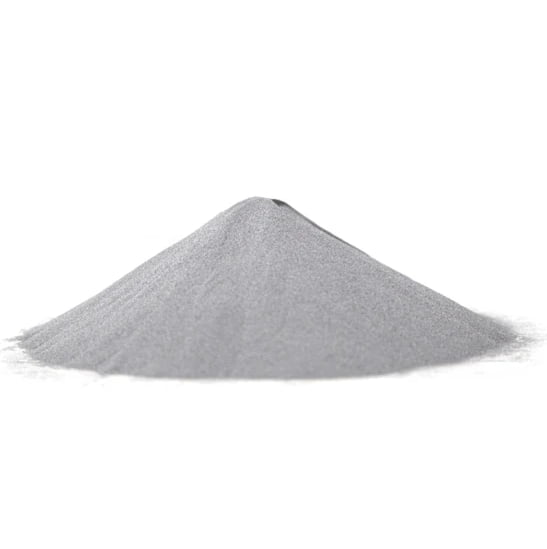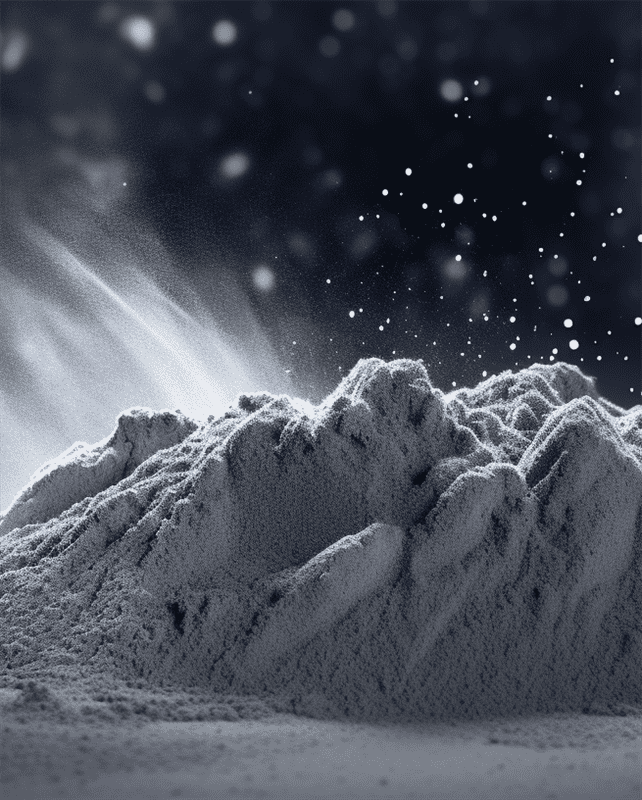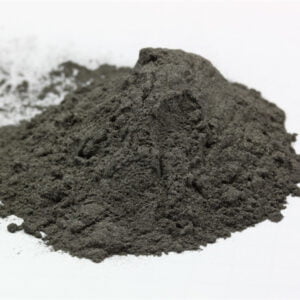Rozprašované kovové prášky: aplikace, specifikace a srovnání
Obsah
Atomizované kovové prášky umožňují výrobní metody, jako je aditivní výroba a tepelné stříkání, které vyžadují suroviny s přizpůsobenou velikostí částic, tvarem a metalurgickými vlastnostmi. Tento průvodce podává přehled výrobních procesů, specifikací, vhodných kovů, použití, výběru dodavatelů a alternativních řešení v oblasti komerčních atomizovaných prášků.
atomizované kovové prášky Přehled
Atomizace přeměňuje proudy roztaveného kovu na jemné sférické kapky, které se rychle ochlazují do formy prášku. Klíčové vlastnosti oproti alternativám, jako je chemické srážení, zahrnují:
- Řízená distribuce velikosti částic od 10 mikronů do více než 300 mikronů
- Schopnost zpracovávat reaktivní slitiny v atmosféře inertního plynu
- Rychlé tuhnutí, při kterém vznikají jemnější mikrostruktury
- Nižší obsah nečistot kyslíku a dusíku
- Nákladová efektivita z vysokých výtěžků prášku zaměřeného na 50%+
- Přizpůsobivost pro přípravu většiny komerčních kovů a slitin
Pochopení dostupných výrobních metod, specifikací, aplikací a ekonomiky umožňuje správně využít výhod a omezení atomizace při výběru kovových prášků.

Metody atomizace kovových prášků
Průmyslová měřítka vyžadují rozprašování pomocí plynu, vody nebo odstředivých procesů:
| Metoda | Popis | Použité kovy | Velikosti částic |
|---|---|---|---|
| Plyn | Nadzvukové proudy inertního plynu přeměňují proud kovu na prášek | Nejčastější. Reaktivní materiály kompatibilní | 10 μm - 150 μm |
| Voda | Vysokotlaká voda rozkládá roztavený kov a vystavuje ho rychlému ochlazení. | Především měď a železo. Omezené množství reaktivních materiálů | 5 μm - 350 μm |
| Odstředivé | Roztavený kov se z rotujícího kotouče zrychluje směrem ven. Rychle se ochladí na prášek. | Většina kovů je kompatibilní. Nižší reaktivní schopnost | 45 μm - 1 mm+ |
Tabulka 1. Komerční atomizační techniky pro výrobu kovových prášků vedle výstupních znaků
Každá z těchto technik poskytuje jedinečné výhody, pokud jde o velikost částic, výtěžnost prášku, rychlost ochlazování a kompatibilitu s expanzivními kovy.
Kovy a slitiny kompatibilní s atomizací
Atomizace životaschopně zpracovává většinu komerčních kovů a slitin včetně:
- Slitiny titanu obsahující hliník a vanad
- superslitiny, jako je Inconel na bázi niklu a slitiny Haynes na bázi kobaltu.
- Vysokoteplotní kovy, jako je molybden, wolfram a tantal.
- Reaktivní prvky, jako je chrom a mangan.
- Drahé kovy včetně zlata, stříbra a platiny
- Žáruvzdorné kovy: niob, zirkonium a hafnium
- Běžné austenitické nerezové oceli 316L a 304L
Silná chemická reaktivita v roztaveném stavu omezuje použitelnost pro některé elementární kovy, jako je čistý mangan nebo chrom. Směšování do slitin však zmírňuje nevýhody reaktivity díky kompatibilitě s atomizací, což je výhoda oproti jiným přístupům výroby prášku.
Charakteristika a vlastnosti Rozprašované kovové prášky
Výsledkem atomizace jsou kovové prášky s vlastnostmi na míru, které vyhovují potřebám výrobního procesu:
Distribuce velikosti částic
- Možnost nastavení velikosti od 10 mikronů do 1 mm, sítování na přesné frakce
Tvar částice
- Převážně sférické morfologie, zejména při atomizaci inertním plynem.
Vnitřní pórovitost
- Rychlé tuhnutí a inertní zpracování minimalizuje množství zachycených plynů, které vytvářejí dutiny.
Chemická čistota
- 99%+ dosažitelné pro materiály rozprašované inertním plynem. Rozprašování vodou o něco méně.
Povrchový oxid
- Vodní rozprašování zachycuje 5-15× více povrchové kontaminace kyslíkem než inertní rozprašovací ochrana.
Mikrostrukturní fáze
- Zaoblení rychlým kalením ve srovnání s odlévanými ingoty.
Schopnost optimalizovat parametry velikosti a tvaru částic při zachování vysoké chemické čistoty a příznivé mikrostruktury se hodí pro atomizované kovové prášky jako vstupní suroviny pro aditivní výrobu, kde tyto vlastnosti rozhodujícím způsobem ovlivňují úspěšnost procesu a výsledné vlastnosti realizovaných dílů.
Specifikace velikosti kovového prášku z atomizace
Dávky atomizovaného kovového prášku se klasifikují na základě distribuce velikosti částic. Mezi běžné velikosti sít patří:
| Síťovina | Velikost mikronů | Typické použití |
|---|---|---|
| +100 | >150 μm | Tepelně stříkané součásti a povlaky |
| -100 +325 | 105 - 150 μm | Prekurzory izostatického lisování za tepla |
| -325/+500 | 32 - 105 μm | 3D tisk pomocí trysky pojiva/studeného nástřiku |
| -500 | <32 μm | Aditivní výroba s tavením v práškovém loži |
Tabulka 2. Kategorie velikosti částic pro klasifikované rozprašované kovové prášky přizpůsobené kompatibilitě výrobních procesů
Většina patentovaných atomizačních systémů se zaměřuje na výtěžnost 50%+ prášku shromážděného v rámci výrobních specifikací po separaci nadrozměrných a poddimenzovaných frakcí, které se recyklují zpět do proudu taveniny.
Průmyslové specifikace pro atomizované kovové prášky
Různá sdružení udržují normy složení, chemických a fyzikálních vlastností pro komerční kovové prášky, včetně:
| Subjekt | Standardní číslo | Pokryté kovy |
|---|---|---|
| ASTM International | F3049 | Titan a slitiny titanu |
| ASTM International | F3056 | Nikl a slitiny niklu |
| ASM International | MMPDS-06 | Vlastnosti více kovových materiálů |
| APMI Int'l | ANSI/APMI B.101 | Měď a slitiny mědi |
Tabulka 3. Obchodní skupiny nabízející specifikace použitelné pro prosévané chemikálie a práškové metriky užitečné pro zajištění kvality atomizovaných materiálů.
Kromě toho jednotliví výrobci poskytují úzce vymezené specifikace týkající se jedinečných slitin nebo speciálních vlastností, jako jsou maximální prahové hodnoty kyslíku nebo dusíku, které jsou kritické pro reaktivní zpracování slitin.
Přezkoumání rozsahu certifikace zajišťuje, že normy řádně pokrývají kupujícím předepsaná okna složení, přijatelné vlastnosti prášku, jako jsou průtoky v hale a úrovně chemické čistoty, které odpovídají jak možnostem atomizace, tak následným požadavkům výrobního procesu.
Aplikace a použití atomizovaného kovového prášku
Klíčové aplikace kovových prášků, které představují základní surovinu pro průmyslovou výrobu, zahrnují:
Aditivní výroba
- Letecké a kosmické komponenty - lopatky turbín, aerodynamické listy
- Lékařské implantáty - kyčelní, kolenní a zubní náhrady
- Nástroje - Lehké konformně chlazené vstřikovací formy na plasty
- Chemické reaktory - Strukturované nosiče katalyzátorů s vysokým povrchem
Tepelný nástřik
- Antikorozní nátěry pro těžbu ropy a plynu - vrtné nástroje
- Povrchy tiskových válců odolné proti oděru
- Náhradní chromované povrchy automobilů
- Formy na architektonické sklo s vysokým uvolňováním a nízkým třením
Prášková metalurgie
- Automobilové převodovky a součásti motoru
- Permanentní magnety v motorech a senzorech
- Diamantové břitové destičky a řezné nástroje
- Elektrické kontakty využívající specifickou vodivost
Základní suroviny slouží pro všechny aplikace vyžadující kombinovanou chemii a rafinovanou strukturu prášku schopnou konsolidace do geometrie pro konečné použití.
Výrobci a prodejci atomizovaného kovového prášku
Mezi přední světové dodavatele, kteří zajišťují atomizaci pro lékařské, letecké a průmyslové trhy, patří:
| Společnost | Umístění |
|---|---|
| Sandvik | Švédsko |
| Tesařská technologie | Spojené státy |
| Praxair | Spojené státy |
| Höganäs | Švédsko |
| PyroGenesis | Kanada |
| Erasteel | Francie |
Tabulka 4. Významní výrobci, kteří nabízejí výrobu kovového prášku rozprašováním z různých procesních technologií
Prášky distribuují také sekundární zprostředkovatelé, ale osvědčené postupy umožňují nakupovat přímo od mlýnů, což zajišťuje sledovatelnost šarží a eliminuje zprostředkovatelská rizika kontaminace kvality materiálů mezi hlavními výrobci a výrobci koncových dílů.
Ceny pro Rozprašované kovové prášky
Ceny se liší podle složení, distribuce velikosti částic, objemu výroby a kvality:
| Materiál | Cena za kilogram |
|---|---|
| Titanium Ti64 | $50 - $150 |
| Niklové superslitiny | $50 - $250 |
| Nerezové oceli | $5 - $30 |
| Nástrojové oceli | $2 - $15 |
Niche slitiny vyráběné v malých sériích vyžadují vyšší ceny, které kompenzují výměnu pece. Komoditní kovy, jako je nerezová ocel, zpracovávané ve velkých objemech, nabízejí nejnižší náklady. Kupující však ověřují spravedlivou relativní hodnotu porovnáním výsledného zvýšení výkonu s použitím v konečných součástech.
Výhody a nevýhody atomizovaného kovového prášku
Výhody rozprašovaných kovových prášků:
- Řízené rozdělení velikosti částic při komerčních výrobních rychlostech
- Sférická morfologie prášku z procesů v inertním plynu
- Rychlé tuhnutí a inertní zpracování zajišťují chemickou čistotu
- Přizpůsobení široké škále potřeb speciálních slitinových surovin
Omezení zvážit:
- 10-100násobné zvýšení nákladů na vstupní suroviny oproti formám tepaných výrobků
- Omezená flexibilita na vyžádání s potřebou dlouhých dodacích lhůt
- Pozor na to, aby se nepřeceňovaly vlastnosti prášku nebo náklady na balón
Správné zvážení přínosů a omezení pomáhá vyhnout se nadměrným výdajům jen proto, aby se použily technologie, které nepřinášejí zákazníkům žádnou znatelnou hodnotu.

Srovnání s jinými metodami výroby kovového prášku
Kompromisy mezi běžnými přístupy k výrobě kovových prášků:
| Metoda | Škálovatelnost | Náklady | Čistota | Řízení částic | Omezení kovů |
|---|---|---|---|---|---|
| Atomizace | Velmi vysoká | $$$$ | Vysoký | Vynikající | Některé elementární kovy |
| HDH | Nízký | $ | Střední | Špatný | Pyroforika |
| Elektrolýza | Vysoký | $$ | Střední až vysoká | Mírný | |
| Chemické srážení | Vysoký | $ | Střední | Špatný |
Tabulka 5. Kvalitativní srovnání metod výroby kovového prášku v komerčním měřítku
Přestože se při atomizaci vyrábějí značné objemy s optimalizovanými vlastnostmi prášku, jsou za ni účtovány cenové přirážky, které by mohly omezit zavádění v odvětvích citlivých na náklady, jako je automobilový průmysl.
Často kladené otázky
Otázka: Jaký je hlavní účel atomizace kovových prášků?
A: Přesné řízení velikosti a tvaru částic, které jsou jinak u jiných technik náhodné, aby vyhovovaly přísným požadavkům aditivních výrobních procesů.
Otázka: Zachovávají si recyklované kovové prášky původní vlastnosti?
Odpověď: Ano, faktory jako zachycení kyslíku a mikrostrukturní fáze se z velké části nemění, což umožňuje opětovné použití jako doplněk k práškům z původní výroby.
Otázka: Lze plynovou atomizací dosáhnout velikosti prášku pod 10 mikronů?
Odpověď: Extrémně jemná distribuce pod 5 mikronů je možná, ale při velmi nízkých výtěžcích není ekonomická pro komerční použití v aditivní výrobě, protože plocha povrchu ovlivňuje reaktivitu.
Otázka: V jakých odvětvích se používají atomizované kovové díly?
Odpověď: Letecký, lékařský, automobilový a ropný/plynový průmysl využívají slitiny a mikrostruktury na míru, které vznikají díky jedinečnosti atomizačního procesu.
Sdílet na
MET3DP Technology Co., LTD je předním poskytovatelem řešení aditivní výroby se sídlem v Qingdao v Číně. Naše společnost se specializuje na zařízení pro 3D tisk a vysoce výkonné kovové prášky pro průmyslové aplikace.
Dotaz k získání nejlepší ceny a přizpůsobeného řešení pro vaše podnikání!
Související články

Vysoce výkonné segmenty lopatek trysek: Revoluce v účinnosti turbín díky 3D tisku z kovu
Přečtěte si více "O Met3DP
Nedávná aktualizace
Náš produkt
KONTAKTUJTE NÁS
Nějaké otázky? Pošlete nám zprávu hned teď! Po obdržení vaší zprávy obsloužíme vaši žádost s celým týmem.

Kovové prášky pro 3D tisk a aditivní výrobu
SPOLEČNOST
PRODUKT
kontaktní informace
- Město Qingdao, Shandong, Čína
- [email protected]
- [email protected]
- +86 19116340731















